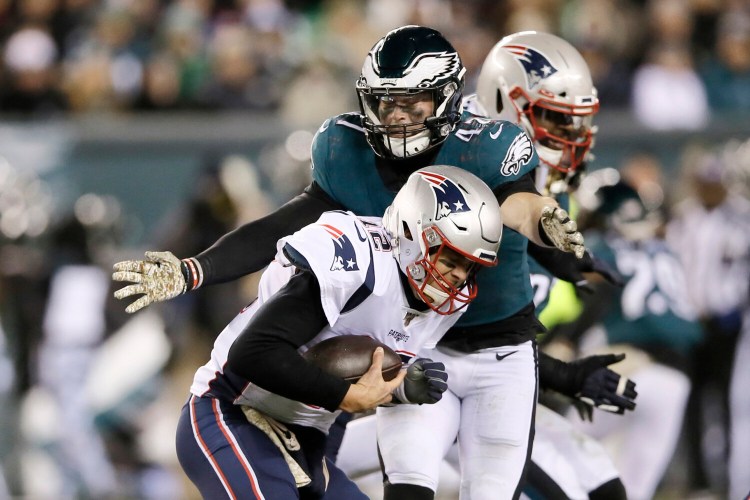FOXBOROUGH Mass. — Tom Brady drops back to pass, bounces in the pocket, then bails to escape pressure.
He throws the ball away.
The camera pans quickly to his face, where frustration flashes. In most games of his Hall of Fame career, that snapshot is a victory for the defense. Except this season, that scene for the Patriots has been a draw.
More than ever, the greatest quarterback of all time is happy to see another down.
According to data compiled by Pro Football Focus, Brady is three throwaways away from setting a career signle-season high. It’s a mini mystery inside a straightforward 10-1 season that’s largely been on cruise control and resumes Sunday in Houston.
Brady said this week that his throwaways aren’t from trying to save his 42-year-old bones from cracking under pressure.
“I wouldn’t be in the self-preservation business if I was trying to be a football player,” he said.
So why is he firing so many dead-end passes?
“I’m throwing it away because I don’t want to take a sack,” Brady answered. “I think part of it’s just you feel like you have an opportunity on the play, and if you don’t have that, then I think negative plays actually have a big impact on the game. Turnovers and negative plays, I think, really keep you from winning games.”
Asked the same question on Friday, Coach Bill Belichick wasn’t keen on espousing any big-picture theory.
“I think we look at each play, try to break it down individually and whatever the comments are on that play – the critiques, criticisms, reinforcements of positive actions on the play – then that’s what we do. As far as breaking down overall trends and all that, each play is different. So I wouldn’t try to lump them all into one category.”
And yet, the trends are there, they’re older than this season and they can’t be explained by leaky pass protection or lesser weapons.
PFF ranks the Pats 15th in pass block efficiency, an average ranking today and for the offense’s last six seasons. Going further back, in 2006 and 2013 Brady was surrounded by appreciably worse wide receivers and threw a combined 25 passes away during those years, two fewer than this season. In fact, by failing to get rid of the ball then, Brady hurt the offense by taking a combined 74 sacks.
The root of this change is Brady’s performance under pressure, which began to pivot in 2014.
PFF data, which goes back to 2006, suggests Brady’s single-season throwaway percentage when under pressure never reached double digits until 2014. Since then, he’s chucked the ball out of bounds almost 12 percent of the time when hurried or hit. Over the last six years, Brady has three Super Bowl rings, two of his best seasons by QBR, one MVP award and … the six highest throwaway totals of his career.
He’s been better, stronger, wiser.
By itself, the throwaway is inefficient, but it can be effective in spots. By avoiding turnovers and drive-killing sacks, the offense gets out of the way of its defense and special teams. That’s never been more valuable than this season.
“The strength of our team is our defense and special teams,” Brady declared in a radio interview on Nov. 18. “So on offense, we just have to take advantage when we get opportunities, understand where our strengths lie and try to play to them. Not giving short fields. Not turning the ball over.”
Brady’s learned from the only three seasons when his throwaway percentage failed to reach 6 percent and he suffered a combined 109 sacks.
He’s not taking those hits anymore. At this rate, Brady will absorb around 26 sacks on the year, which is on par for his career.
He’s not risking picks. Brady’s interception rate of 1.1 percent is on track to rank as the third-lowest of his career for a full season.
He’s simply throwing it away.
And living to win another day.
“If I’m going to hold it back there, then usually good things aren’t going to happen,” Brady said. “So (I) try to throw the ball away to a safe place and live for the next down.”
Comments are not available on this story.
Send questions/comments to the editors.


